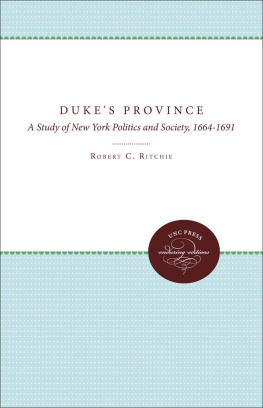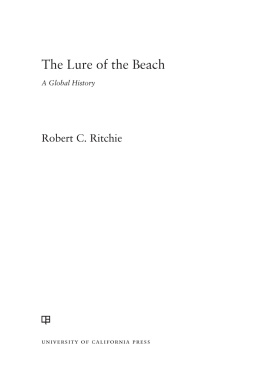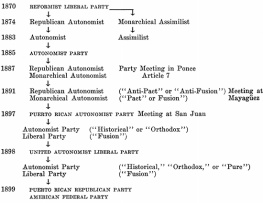Copyright1977 by
The University of North Carolina Press
All rights reserved
Manufactured in the United States of America
ISBN 0-8078-1292-7
Library of Congress Catalog Card Number 77-681
Library of Congress Cataloging in Publication Data
Ritchie, Robert C 1938
The Dukes Province.
Bibliography: p.
Includes index.
1. New York (State)Politics and governmentColonial period, ca. 16001775. 2. New York (State)Economic conditions. 3. New York (State)Social conditions. 1. Title.
JK99.N69R57 309.174702 77-681
ISBN 0-8078-1292-7
Acknowledgments
Anyone laboring for many years on a project such as this acquires many debts to people and institutions. I wish to take this opportunity to express my gratitude to those who have helped me in my work.
It is a pleasure to recall the many courtesies extended to me by the librarians of the Henry E. Huntington Library, the New York Historical Society, the New York State Library, the Franklin D. Roosevelt Library, the Queens College Library, the Public Record Office, the British Museum, the Institute of Historical Research, the Bodleian Library, the Cambridge University Library, and the libraries of the University of California at Los Angeles and San Diego.
The Graduate School and the History Department of the University of California Los Angeles provided me with the resources to begin this project. I am grateful also to the committee on research of the University of California San Diego and to the Regents of the University for their support which allowed me to complete my research and writing.
I would like to thank the editors of New York History and the New York Historical Society Quarterly for permission to draw upon earlier versions of some of the material in this book published in their journals. I should also like to express my gratitude to the New York State Historical Association and its prize committee that awarded me the associations manuscript award for 1975.
My warmest thanks go to my friends and colleagues who have been so generous with their time and energy. Eugene S. Larson, Mary Beth Norton, Joyce Goodfriend, Andrew Appleby, Roger Daniels, Frances Makkreel, and Linda Mehr have patiently listened to me through the years and just as patiently offered their advice. Michael Kammen and Patricia Bonomi gave me much needed encouragement and shared their special knowledge of New York history. Arthur Joseph Slavin, Joyce Appleby, Stanley Chodorow, Harry N. Scheiber, and David Ringrose read and critiqued the manuscript in one of its many manifestations.
I am particularly appreciative of the encouragement given me by Keith Berwick and Wesley Frank Craven who also inspired me to begin this study. Gary B. Nash offered invaluable advice during the process of its completion and without his concern this work would not be the same. Needless to say I alone am responsible for the errors and imperfections that remain.
Finally, I thank Louise Nocas Ritchie for her enthusiasm and encouragement.
The Dukes Province
Introduction
This work is a political and social history of New York from 1664 to 1691. Scholars have largely ignored this period just as they have neglected it in the history of the other American colonies. But while this period lacks the drama of the Revolution or of the era of discovery and settlement, nevertheless recent work has demonstrated that it was important as an era of transition between rough-hewn settlements and established provincial life. This is the period when political institutions and practices were formulated; when entrepreneurial activity set the pattern for future commercial growth; when elite groups established their position in society and politics; when the slave system was hammered out; when the basic structure of the English empire was created; and when the colonists reshaped the social structures of the Old World to fit the imperatives of life in the new. These developments created strains that came to the fore in rebellion, riot, resistance to authority, personal anxiety, and religious doubt.
New York had all these problems and more, for its social, economic, and political history was complicated by both political and ethnic problems. Seized from the Netherlands in 1664, New York became the proprietary colony of James, duke of York, the future James II. After a brief return to Dutch rule from 1673 to 1674, New York remained a proprietary colony until York ascended the throne in 1685. Between 1685 and 1691, it became in rapid succession a royal colony, part of the Dominion of New England, the scene of a major rebellion, and once again a royal colony. Thus, on the basis of political change alone, New York compels attention. In addition, its unique bicultural population, the legacy of the original Dutch colonization, complicates the study of all of the problems afflicting the colonies. The only comprehensive study of New Yorks history in this period was published by John R. Brodhead in 1871. Subsequently, other historians have concentrated on places, such as Maria Van Rensselaers work on New York City, or on individuals, as Lawrence Leder did in his study of Robert Livingston, or on events, as in Jerome Reichs Leislers Rebellion. Brodhead provided a detailed narrative of events that will not be reproduced here. My purpose will be to illuminate the interaction between the government and the people and to concentrate on social, economic, and political developments.
In recounting New Yorks history in this period, I have focused upon four themes. The first theme is the relationship between the government and the people. During these years the colonists struggled to create systems of government consistent with their own social views that could, at the same time, gain acceptance in England, the ultimate source of legitimacy for their governments. In New York, as in the other proprietary colonies, the colonists faced the added dilemma of reconciling their wishes with the plans of the proprietor, which often did not take into account the realities of life in North America. The duke of York wanted a system of government that concentrated power in the hands of the executive. Popular government, in any of its manifestations, was anathema to him. As a result, New Yorkers struggled to gain access to the governor and, failing that, to get the government changed. This struggle should not be interpreted as the whig historians might have, as the fulfilment of a liberal ideology, but rather as an attempt to protect and extend the gains made by individuals and local communities. Only toward the end of this period were ideas about the nature of popular government articulated. If anything, New York politics in this period was characterized by particularism and selfishness rather than lofty ideals.
Second, New York was unique among North American colonies. After conquering New Netherland, the English found themselves in contol of Dutch colonists whose loyalties and culture differed from their own. As the number of English colonists grew and the interrelationships within and between communities became more complex, the Dutch came under increasing pressure to Anglicize. They were the first European group confronted with this problem, and their experiences prefigured those of many later immigrant groups to America.






